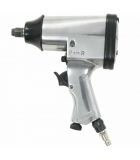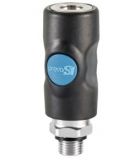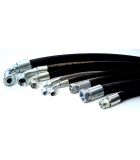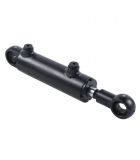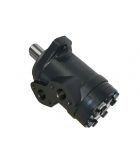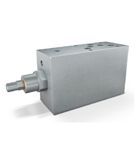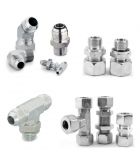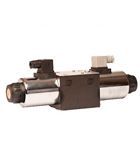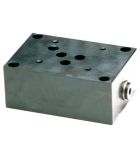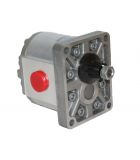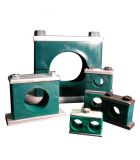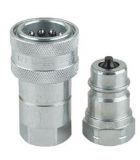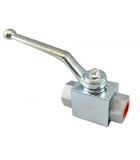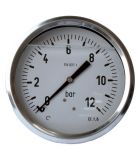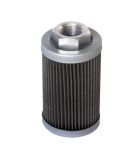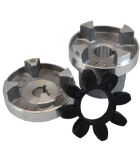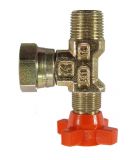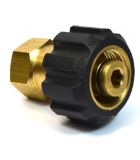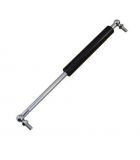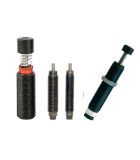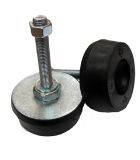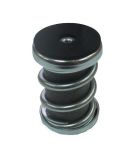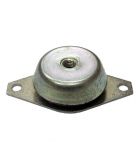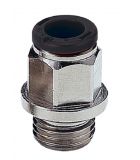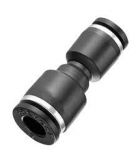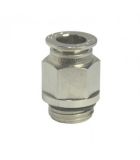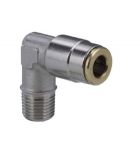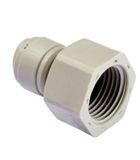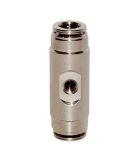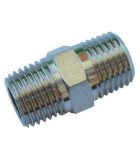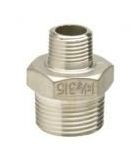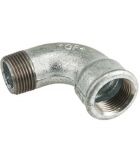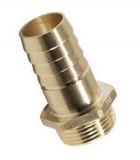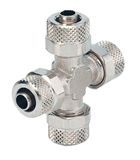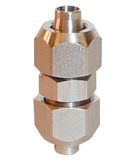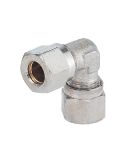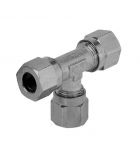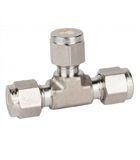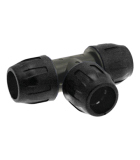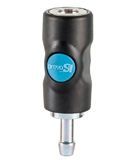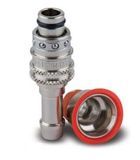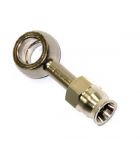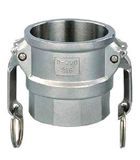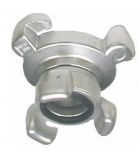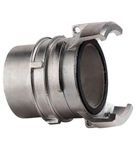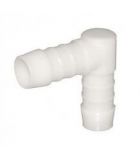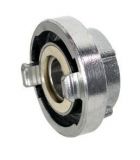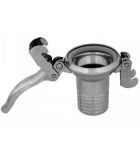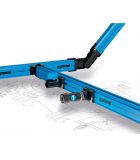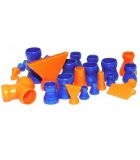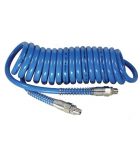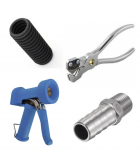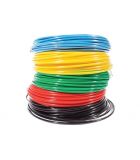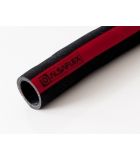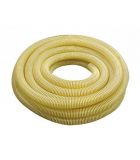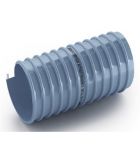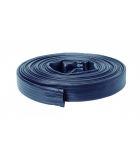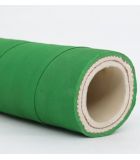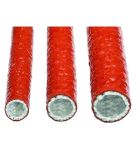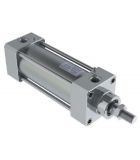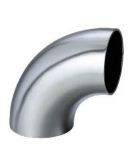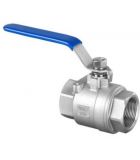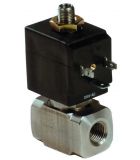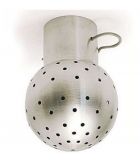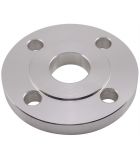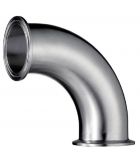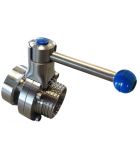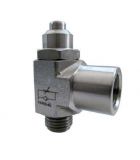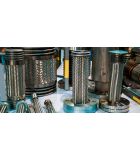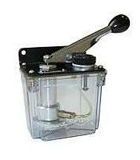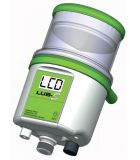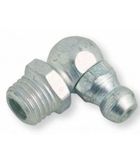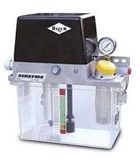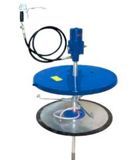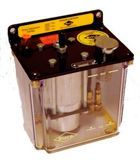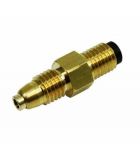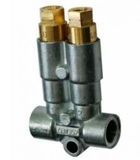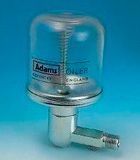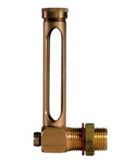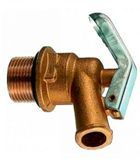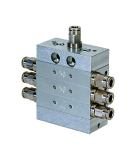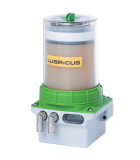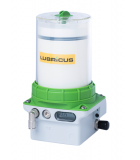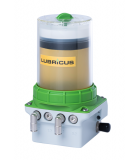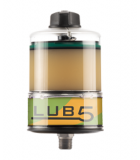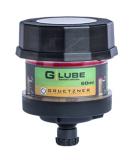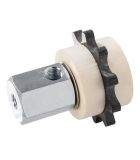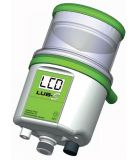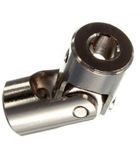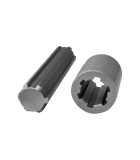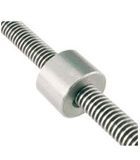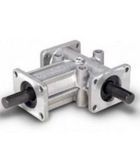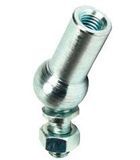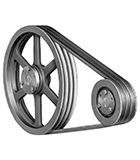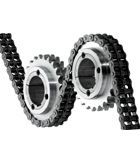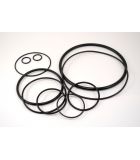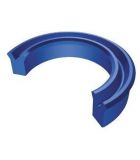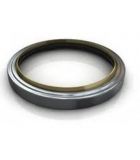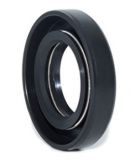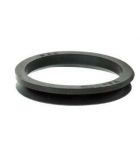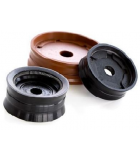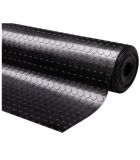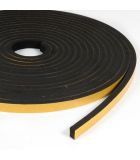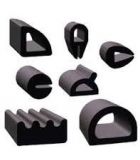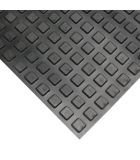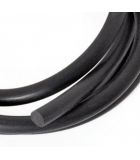PNEUMATICS
Subcategories
-
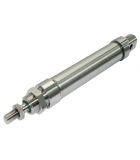
PNEUMATIC CYLINDERS
<h2><b>Pistons or pneumatic cylinders. Buy single-acting or double-acting cylinders.</b></h2><p style="text-align:justify;"> <strong>Pneumatic cylinders or pistons</strong> are mechanical elements that transform the energy of compressed air into kinetic (movement), linear or rotary energy. These cylinders perform movements, linear, rotary and angular movements, feeding and lifting. They have the power to make instantaneous changes of direction.</p><h3 style="text-align:justify;"> Function of pneumatic cylinders-pistons</h3><p style="text-align:justify;"> The function of pneumatic cylinders can be single or double acting. Their diameters range from 6 to 320 mm and they can exert a force of 3 to 55,000 Nw. The speed ranges from 25 mm/sg to 1 mt/sg.</p><h3 style="text-align:justify;"> Types of pneumatic cylinders-pistons</h3><p style="text-align:justify;"> The types of pneumatic cylinders can be the standard type that comply with the ISO-6431 ISO-6432, ISO-21287, ISO-15552 VDMA and CNOMO standards, compact guided cylinders, gripping cylinders, telescopic cylinders, cylinders with hollow stem for vacuum, cylinders turning, rodless cylinders, magnetic cylinders, bellows cylinders, metering cylinders and pneumatic grippers.</p><h3 style="text-align:justify;"> Pneumatic piston parts</h3><p style="text-align:justify;"> The main parts of a pneumatic piston are:</p><ul><li> The stem</li><li> The cylinder heads</li><li> The Piston</li><li> The boards.</li></ul><p style="text-align:justify;"> They are simple elements and easy to assemble. It requires little maintenance and is economical to install. Long durability, changing the gasket kit. Pneumatic cylinders can be manufactured from a wide variety of materials and can be used in extreme conditions.</p><p style="text-align:justify;"> Pneumatic cylinders are safe, do not have explosive characteristics or produce excessive heat. The compressed air used to move the pneumatic cylinders does not generate water hammer, which reduces breakdowns or damage to the equipment. They are used in practically all types of industries, where automation is present.</p> -
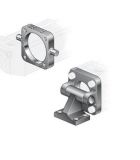
PNEUMATIC CYLINDER FIXINGS
<h2>Fixings for pneumatic cylinders. Buy online at the best price.</h2><p> The fixings for pneumatic cylinders are elements that are attached to the pneumatic cylinders and their fastening is a very important part for carrying out maneuvers.</p><h3> Function of pneumatic cylinder fixings</h3><p> The function of the fixations is to adapt in each case a movement, both linear and angular, static or dynamic fixation. all of them standardized according to ISO 21287, ISO15552, AFNOR, NF, DIN standards for total interchangeability.</p><h3> Types of fixings for pneumatic cylinders</h3><p> The types of fixings for pneumatic cylinders can be the standard type that comply with the ISO-6431 ISO-6432, ISO-21287, ISO-15552 VDMA and CNOMO standards, compact guided cylinders, clamping cylinders, telescopic cylinders, cylinders with hollow rod for vacuum, turning cylinders, rodless cylinders, magnetic cylinders, bellows cylinders, dosing cylinders and pneumatic clamps and their types are, squares, straight hinges, angled hinges, flanges, forks, ball joints, alignment compensators, tenon and plates.</p><p> They are manufactured in steel, cast iron and aluminum. They are simple elements and easy to assemble. It does not require maintenance and its installation is economical and has a long durability.</p> -
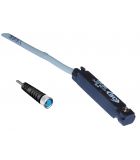
PNEUMATIC CYLINDER SENSORS
<h2>Sensors for pneumatic cylinders. Buy online at the best price</h2><p> Sensors for pneumatic cylinders are electronic elements that transform a magnetic energy signal produced by a magnet carried by the cylinder itself to give an electrical or electronic signal. This detection is made through the cylinder wall, usually made of aluminum, and sent to a controller for further processing. Cylinder sensors are characterized by high switching frequencies, resistance to dust and dirt and easy handling.</p><h2> Function of sensors for pneumatic cylinders</h2><p> The function of the sensors is to provide precise positioning of the piston rod that carries the pneumatic cylinder and to be able to dialogue with the electronic systems of the machine's governance.</p><p> Accurate position detection on cylinders is important to ensure consistent production, for example in the following application areas:</p><ul style="list-style-type:disc;"><li> Packaging technology</li><li> Handling</li><li> Special machinery construction</li><li> Process engineering</li><li> Process automation</li></ul><p></p><h3> Sensor types</h3><p> The types of sensors for pneumatic cylinders can be installed on all types of cylinders ISO-6431 ISO-6432, ISO-21287, ISO-15552 VDMA and CNOMO, Compact guided cylinders, pinch cylinders, telescopic cylinders, cylinders with hollow rod for vacuum, cylinders turning, rodless cylinders, magnetic cylinders, bellows cylinders, metering cylinders and pneumatic grippers.</p><p> The sensors can be 2-wire, Reed type, operating with a switching frequency of 1,000 Hz per second, with direct or alternating current, or 3-wire, open or closed contact PNP –NPN. These other cylinder sensors use a GMR cell that It can deliver a maximum of 10,000 signals per second.</p><p> In addition, protection against short circuits and overvoltages is installed by default.</p><h3> Parts of pneumatic cylinders</h3><p> The main parts of a pneumatic cylinder are:</p><ul style="list-style-type:disc;"><li> The cable can be 2 or 3 wires</li><li> The cable connection can be seen or with a standard M-8 or M-12 connector.</li><li> The internal electronic part, which includes an LED, a probe, an oscillator, an output circuit, among other elements, and a fixing screw to fix it to the cylinder.</li></ul><p> They are simple elements and easy to assemble. It requires no maintenance and is economical to install. Long durability. They are mounted in the slot that the cylinder has incorporated or by means of a fixing flange for any type of profile that the cylinder has. It can be mounted in any position.</p><p> The pneumatic cylinder sensors are safe, do not have explosive characteristics or produce excessive heat. They can be supplied with ATEX regulations</p> -
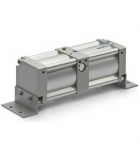
PRESSURE MULTIPLIERS
<h2>Pressure multipliers. Buy pressure multipliers online.</h2><p> Pressure multipliers are mechanical elements that increase the pressure of compressed air. There are times</p><p> that the pressure generated by the compressor is not sufficient to perform a given force. In this case,</p><p> You can mount these pressure multipliers. They can be single-acting and double-acting. Supports a pressure of</p><p> entrance from 3 to 8 bar.</p><h3> <strong>Function of pressure multipliers.</strong></h3><p> Allows a higher outlet pressure than the start-up of the chosen compression ratio. The</p><p> Pressure multipliers are available with compression ratios of 2.5:1 and 3.5:1, the control circuit</p><p> Integrated into the system allows you to obtain the desired pressure by adjusting only the inlet pressure. Easy to</p><p> apply, its small size, with a good flow rate can be the answer to all practical applications and</p><p> economical that require a higher pressure than that supplied by the installed compressor.</p><h3> <strong>Types of pressure multipliers</strong></h3><p> There are 2 types of pressure multipliers.</p><ol><li> Air-Air The MPA air-air pressure multiplier is used to increase the force of pneumatic cylinders and obtain greater forces with reduced dimensions and lower weight, for blowing components at high pressure, for testing or bursting tests of components, etc...</li><li> Air-Oil The "MPO" series air-oil pressure multiplier is a device that consists of a cylinder whose stem acts directly on the oil in the chamber by increasing the high pressure value of 200 bar. In the single-acting version we pressurize a volume of 25 cc with a compression ratio of 30:1 or 50 cc with a compression of 25:1. For different volumes or compression ratios, consult our technical service. The multipliers are supplied with brackets to fix to the machine. Upon request it can be supplied with an external oil tank, pressure gauge and pressure switch.</li></ol><h3> Parts of pressure multipliers.</h3><p> The main elements for the correct assembly of a pressure multiplier circuit are:</p><ul style="list-style-type:disc;"><li> The pressure multiplier, to generate the pressure increase of the compressed air.</li><li> A compressed air treatment unit, to have quality air.</li><li> A pressure regulator, this is what will determine the pressure, using a manometer.</li><li> Check valve, to prevent the compressed air from flowing back.</li><li> A boiler or tank to store the air once the pressure has increased and is constant.</li></ul><p></p><p> They are simple elements and easy to assemble. It requires little maintenance and is economical to install. Long durability, pressure multipliers are safe, they do not have explosive characteristics or produce excessive heat.</p><p></p><p> It is used in any type of industry where it is required to increase the pressure generated by the compressor.</p> -
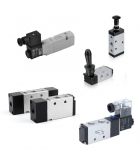
PNEUMATIC DISTRIBUTORS
<h2>Pneumatic distributors. Buy tire distributors online.</h2> <p>Pneumatic distributors are mechanical devices that direct and regulate the movement of compressed air; They govern the exit and entry, closing or enabling, direction and flow of compressed air, in all its devices or peripherals. They are usually pneumatic cylinders</p> <h3>Types of pneumatic distributors</h3> <p>The types of pneumatic distributors could be selected from:</p> <ul><li>Position or direction control distributor (distributors) These valves control the direction and diversion of air to the associated elements. Start and stop.</li> <li>Distributor or flow valve. Also called flow control valve. Their mission is to regulate the speed of the pneumatic cylinder, regulating the flow of compressed air.</li> <li>Distributor or pressure control valve. Its main function is to protect other elements of the electrical circuit from overpressures. Therefore, if they detect a high pressure in the circuit, reaching the maximum level, it will cut off the air flow. In this way, by cutting and opening the air flow, it is possible to constantly stabilize the pressure of the pneumatic circuit.</li> </ul><h3>How pneumatic and parts distributors work</h3> <p>A distributor valve consists of two parts, completely differentiated. One would be the body, the so-called distributor, and the pilot or drive. The body consists of a casing or box, normally made of aluminum that houses a slider or clapet inside, which are responsible for distributing the compressed air from one path to another.</p> <p>The piloting is the way we change the inner slide. There are several types:</p> <ul style="list-style-type:disc;"><li>Pneumatic, through a compressed air signal, makes the slider or internal clapper move</li> <li>Electric. A coil with alternating or direct current causes a magnetic field and moves the internal slider or clapper.</li> <li>Manual, The movement of the slide or clapet is carried out manually</li> <li>Mechanics. Made by mechanical elements, such as pulleys, antennas, limit switches, stops, pivots, etc.</li> </ul><p>They are simple elements and easy to assemble. It requires little maintenance and is economical to install. Long durability, changing the gasket kit.</p> <p>To identify each valve or distributor and the type of actuation, a universal symbology has been applied that determines it.</p> <p>Pneumatic distributors are safe, do not have explosive characteristics or produce excessive heat. The compressed air used to move the pneumatic cylinders does not generate water hammer, which reduces breakdowns or damage to the equipment. They are used in practically all types of industries, where automation is present.</p> -
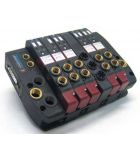
SIM-150 MULTIPOLAR INTEGRATED SYSTEM
<h2>Integrated valves Multipolar SIM-150 system. Buy online at the best price</h2><p> The SIM 150 valve line combines the flexibility and simplicity of assembly of valves on multiple bases as well as the advantage of the wiring and pneumatic assembly system of the most advanced batteries.</p><p> An exclusive double electropilot housed on one side of the valve allows powering even bistable valves, significantly reducing the total size of the battery. The simple and intuitive assembly system allows quick assembly of any type of configuration, ensuring great versatility of use. Signal through activation LED.</p><p> The wide range of valves and modules available allows the creation of true integrated systems of up to 20 bistable solenoid valves, or 40 pilots, responding effectively to the numerous application demands.</p><ul style="list-style-type:disc;"><li> Voltage of 24v DC +/- 10%, Power 1.3 W</li><li> The electrical configuration is through PNP signal.</li><li> The electrical connection is through a 25-pin multipolar connector (from 2 to 10 valve positions, protection degree IP40 or</li><li> 44-pin multipolar connector (2 to 20 valve positions) Protection degree IP65</li></ul><p> It is recommended for assembly to have filtered air with or without lubrication.</p> -
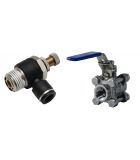
PNEUMATIC VALVES
<h2>Pneumatic valve. Buy pneumatic valves at the best price</h2><p> Pneumatic valves are elements that are operated manually, usually with a lever or a knob. Its function is to direct or cut off the passage of compressed air or any fluid.</p><p> Pneumatic distributors are mechanical devices that direct, manipulate and regulate the movement of compressed air; the closing or enabling, the direction and the flow of compressed air, in all its devices or peripherals.</p><h3> Pneumatic valve types</h3><h4> Pneumatic auxiliary valves:</h4><ol><li> Flow regulating valves. Using a knob, this type of valve regulates the speed of a cylinder or peripheral associated with it.</li><li> Blocking valves, This type of valve, through an internal device, prevents a cylinder from falling suddenly in the event of a breakage or accident, thus avoiding breakages or damage that could be caused.</li><li> Slide valves These valves are used to empty a compressed air circuit, using a slide.</li><li> Non-return or check valves. These valves leave the passage of compressed air free in one direction and prevent passage in the opposite direction.</li><li> Safety valves. The safety valve is a safety device used to evacuate the necessary fluid flow from a container, installation or equipment under pressure, in such a way that it does not constantly exceed the maximum admissible pressure. This valve defines the maximum pressure, preventing it from exceeding it; a spring opens to let excess pressure escape.</li><li> Logic valves There are a series of valves to control certain maneuvers used for pneumatic piloting, such as circuit selectors, NOT valves, simultaneity valves, sensors, quick exhausts, etc.</li></ol><h4> Manual pneumatic valves:</h4><ol><li> Ball or sphere valves are a stopcock mechanism that serves to regulate the flow of a channeled fluid and are characterized by the fact that the regulating mechanism located inside is shaped like a perforated sphere. The sealing is done using a Teflon gasket.</li><li> Butterfly valves, A butterfly valve is a device to interrupt or regulate the flow of a fluid in a pipe by increasing or reducing the passage section by means of a plate or disc, called a "butterfly", that rotates on an axis. By decreasing the passage area, the local pressure loss in the valve increases, reducing the flow. The closure is varied depending on the fluid that circulates. It can be EPDM, NBR, PTFE. The disc can also be made of stainless steel or steel.</li></ol><p> They are simple elements and easy to assemble. It requires little maintenance and is economical to install. Long durability.</p><p> Pneumatic manual valves are safe, do not have explosive characteristics or produce excessive heat. They are used in all types of industries and sectors, given their wide range of uses.</p><p> Pneumatic distributors are safe, do not have explosive characteristics or produce excessive heat. The compressed air used to move the pneumatic cylinders does not generate water hammer, which reduces breakdowns or damage to the equipment. They are used in practically all types of industries, where automation is present.</p><p></p> -
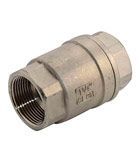
NON-RETURN VALVES
<h2>Non-return valves. Buy online at the best price</h2><p> A <strong>non-return valve</strong> , also known as a check valve or check valve, is a device used in piping and duct systems to allow a flow of fluid (liquid or gas) to flow in one direction and prevent it from flowing in the opposite direction. . These valves are designed to prevent fluid backflow and keep it in the desired direction.</p><p> Non-return valves operate by using an internal mechanism that allows fluid to flow freely in one direction (forward flow) and automatically closes when flow is detected in the opposite direction (reverse flow). This can be achieved through different mechanisms, such as a gate, disc, ball, flap, diaphragm or other devices that block the passage of fluid when the pressure or flow in the undesired direction exceeds a certain threshold.</p><p> Non-return valves are essential in a variety of applications, including plumbing systems, heating systems, cooling systems, pumping systems, compressed air systems and many other industrial and commercial applications. Its use ensures that fluids flow in the correct direction, avoiding equipment damage, safety issues, and unwanted system backups.</p><p> The pressure ranges are very wide depending on the application and the material it is made of, in steel, stainless steel, brass, plastic and its derivatives, nickel-plated brass. Non-return valves are applied in all types of industry.</p> -
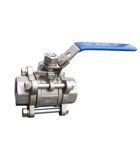
BALL VALVES
<h2>Ball valves. Buy online at the best price</h2><p> A ball valve, also known as a ball valve or floating ball valve, is a device used to control the flow of liquids or gases through a conduit or pipe. These valves are very popular due to their simplicity and effectiveness in regulating flow. They are usually manually operated.</p><h3> Features of a ball valve:</h3><ol><li> Sphere: In the center of the valve there is a perforated sphere or with a hole that can rotate. When the ball is in the closed position, the hole is aligned with the pipe passage and allows flow to pass through. When the sphere is rotated 90 degrees, the hole is perpendicular to the conduit, blocking flow.</li><li> Simple Operation: The ball valve is operated by a quarter turn, making it easy to open or close quickly.</li><li> Effective Sealing: The ball on the ball valve fits tightly against the valve seats, preventing leaks when the valve is closed.</li><li> Versatile Applications: Ball valves are used in a wide variety of applications, including water, gas, oil, chemical, industrial process systems and more.</li><li> Sizes and materials: They are available in a variety of sizes and materials, such as stainless steel, bronze, PVC, brass, nickel-plated brass, steel, among others, which makes them suitable for different environments and substances.</li><li> Low pressure or high pressure use: Ball valves can be used in low and high pressure applications, depending on their design and construction.</li><li> Easy maintenance: Ball valves are generally easy to maintain and repair, as some can be disassembled to access internal parts.</li><li> Handles or actuators: For ease of operation, ball valves often have handles to operate them manually. It is also possible to incorporate electric or pneumatic actuators to automate the opening and closing process.</li></ol><p> Ball valves are a common choice in all types of systems and all types of industries. And for domestic use, irrigation systems, industrial applications, oil and gas transportation systems, and many other fields where flow control is required. Their simple design, ease of use and sealing effectiveness make them a popular choice for many applications.</p> -
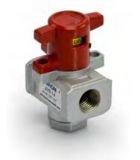
3 WAY VALVES
<h2>3-way valves. Buy at the best price</h2><p> A 3-way ball valve, also known as a ball valve or floating ball valve, is a device used to control the flow of liquids or gases through a conduit or pipe. These valves are very popular due to their simplicity and effectiveness in regulating flow.</p><p> They are usually manually operated. They can be diverter "L" passage or mixing "T" passage</p><h3> Features of a 3-way ball valve:</h3><ol><li> Sphere: In the center of the valve there is a perforated sphere or with a hole that can rotate. When the ball is in the closed position, the hole is aligned with the pipe passage and allows flow to pass through. When the sphere is rotated 90 degrees, the hole is perpendicular to the duct, blocking the flow or giving way to the other path depending on the function it has.</li><li> Simple Operation: The 3-way ball valve is operated by a quarter turn, making it easy to open or close quickly.</li><li> Effective Sealing: The ball on the 3-way ball valve fits tightly against the valve seats, preventing leaks when the valve is closed.</li><li> Versatile Applications: 3-way ball valves are used in a wide variety of applications, including water, gas, oil, chemical, industrial process systems and more.</li><li> Sizes and materials: They are available in a variety of sizes and materials, such as stainless steel, bronze, PVC, brass, nickel-plated brass, steel, among others, which makes them suitable for different environments and substances.</li><li> Low pressure or high pressure use: Ball valves can be used in low and high pressure applications, depending on their design and construction.</li><li> Easy maintenance: Ball valves are generally easy to maintain and repair, as some can be disassembled to access internal parts.</li><li> Handles or actuators: For ease of operation, ball valves often have handles to operate them manually. It is also possible to incorporate electric or pneumatic actuators to automate the opening and closing process.</li></ol><p></p><p> 3-way ball valves are a common choice in all types of systems and all types of industries. And for domestic use, irrigation systems, industrial applications, oil and gas transportation systems, and many other fields where flow control is required. Their simple design, ease of use and sealing effectiveness make them a popular choice for many applications.</p> -
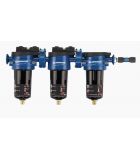
COMPRESSED AIR TREATMENT SYSTEMS
<h2>Compressed air treatment systems</h2><p> In many industries, compressed air requires additional treatment once compression has been performed. Compressed air contains liquid and solid impurities. The first are mainly traces of oil from the compressor and water vapor. The second are formed by the vacuumed dust and solid particles released from the installation due to oxidation effects. Both reduce the useful life of pneumatic equipment.</p><p> Air as an energy medium is available almost unlimitedly throughout the world, however it requires different degrees of quality, depending on its use. The air is different in different climate zones, due to pollution produced by traffic, industry, agriculture and other factors. This aspect must be taken into account when treating compressed air.</p><p> With proper treatment of compressed air, machine breakdowns and downtime can be significantly reduced. Also, as a process medium, compressed air must be adequately treated. The quality of compressed air is governed by the following requirements.</p><p> The ISO8573-1 standard determines the amount of dirt permissible per cubic meter of compressed air. Solid particles, water and oil are the 3 main types of dirt. Consequently, different processes overlap in the treatment of compressed air. The load of germs and bacteria also deserves special attention. The DIN-ISO 8573-1 standard does not define limits for germs or microorganisms.</p><p> There are a wide variety of compressed air auxiliary products that help treat air, including air dryers, filters, purges, water separators, lubricators, regulators, reboilers or reservoirs.</p><p> Compressed air is used in a wide range of industries and in many different ways. The requirements regarding its quality and purity vary according to the sector where it will be used.</p><p> The standards applied in an industry such as textiles may vary completely from those applied in the food or medical industries, which require completely oil-free compressed air.</p> -
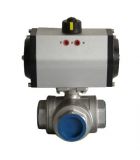
PNEUMATIC ACTUATORS
<p><strong>Buy Pneumatic Actuators online</strong></p><p class="MsoNormal"> Pneumatic actuators are usually of two types, single and double acting, they are used to automate all types of valves with ISO-5211 coupling plate, ball valves, butterfly valves, food valves, hydraulic valves, 2-way and three-way valves.</p><p> <strong>Single-acting actuators</strong> only need an air signal, they return using springs. <strong>Double-acting actuators</strong> require 2 different air signals to open and close the valves.</p><p> pneumatic actuators<span> </span>They are provided with opening regulation, using two screws. The movement is produced by a rack and pinion.</p><p> Possibility of choosing a wide torque level, from 9 to more than 48,000 N/m<span> </span>at different pressures.</p><p> Pneumatic actuators can carry atex certification in various environments. Up to standard protection<span> </span>II 2GD c T4.</p><p> In single and double acting actuators we can connect the <strong>control solenoid valves</strong> directly to the NAMUR plane. Likewise, a limit switch can be connected that can be mechanical, electromechanical or inductive, this allows us to have total control of the movements and status of the valve.</p><p> Applications of pneumatic actuators:<span> </span>In all types of industry where valve automation is required, in the opening, closing and mixing of both gases and liquids.</p> -
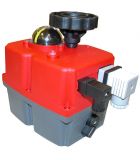
ELECTRICAL ACTUATORS
<h2>Electric Actuators. Buy them online at the best price and with fast shipping.</h2><p> Electric actuators or motorized valves are devices that transform electrical energy into kinetic energy, producing rotary movement. They are specially developed and designed for valve automation, which transmits the torque necessary to operate the valve.</p><p> They have the ISO-5211 coupling plane to adapt to the valves. In some cases it has a handwheel, which is part of the standard equipment, allowing the valve to be manually operated with very large sizes or sizes. This movement is usually 0 – 90º, allowing the valves to be opened or closed.</p><p> To rotate the valve, torque (the rotational equivalent of linear force) is required. The electric actuator generates this torque and transmits it to its output shaft, which connects to the valve stem or shaft. This, in turn, rotates the valve ball or disc and opens or closes the orifice to allow passage or block flow. The amount of torque generated by an actuator depends on its gearing and the capacity of the motor. The motor capacity (torque) is an important specification for the actuator as it must be greater than the torque required by the valve to ensure that it can open and close the valve. Typically, starting torque is specified as the required torque of a valve, as it is the highest torque required to turn the valve.</p><p> Electric actuators are made up of an electric motor that, together with a reduction box, allows to drive an axis, this is the one that rotates 90º allowing the opening or closing of the valve, as mentioned previously. There are some models that can rotate 180º or 270º The entire assembly is protected by a box made of plastic prepared to place the cables using DIN connectors.</p><p> They are available in various operating voltages, 12 VDC, 24VDC, 24VAC, 220VAC IP67 protection. They incorporate a thermal temperature sensor and a manual emergency control for possible malfunctions or emergency stops. They are equipped with a visual open/closed indicator, to which cables can be connected to transmit an electrical signal to other peripherals. We can also place limit switches, which are an electromechanical component of the actuators.</p><p> They consist of a closing stroke limit cam and an opening stroke cam. When the actuator moves a valve to the open or closed position, the corresponding switch cam moves. When a final position is reached, the corresponding switch cam cuts off the electricity. This prevents further movement and provides a limit seat. Limit seating is the maintenance of a valve in the desired final position. On some actuators, the limit switch cams are adjustable. This allows you to set a position, such as 75% open, as the final position. Limit switch cams can be incorporated into position indicators as a mechanical link between the valve and the actuator.</p><p> They have a high range of torque. It also incorporates an electrical torque control, which means that it disconnects if the torque is exceeded, to prevent possible damage or breakage. It also has a manual control or emergency command. Electric actuators are used to remotely control ball, butterfly and other valves, greatly increasing the ease of operation of 90° turn valves by providing remote and automated control.</p><p> They also provide sufficient torque for valves that require higher torques that cannot be generated by a human. These actuators are used in industrial automation, irrigation, water supply, fluid dosing, heating systems and fluid transportation or transfer, in any type of industry.</p> -
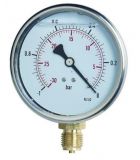
PNEUMATIC VACUOMETERS
<h2>Pneumatic vacuum gauges. Buy online at the best price</h2><p> A <strong>vacuum gauge is an instrument used to measure pressure in a vacuum environment</strong> . (depression) Essentially, it works by measuring the force needed to attract a diaphragm or spring to a specific position. This is accomplished through a sensor that measures the deflection of the diaphragm or spring and converts it into a pressure reading. The units in which vacuum is usually measured are Bar, millibar, atmospheres, psi or mmHg.</p><p> The most common sizes of vacuum gauges can be, diameter 40, 50, 63, 100 and 160 mm. They can have a glycerin bath to dampen measurements and vibrations. Glycerin is a transparent, viscous liquid that has a high density and low evaporation.</p><p> Due to their physical properties, vacuum gauges are used in a variety of applications where it is important to measure and control pressure in a vacuum environment.</p><p> Some of the <strong>common applications of vacuum gauges</strong> include:</p><ul style="list-style-type:disc;"><li> <strong>Electronic Device Manufacturing:</strong> Vacuum gauges are used in the manufacturing of semiconductors and other electronic devices to monitor pressure in layer deposition and layer removal processes.</li><li> <strong>Vacuum industry:</strong> Vacuum gauges are used in the vacuum industry to monitor the pressure in vacuum chambers used in research and the manufacture and use of suction cups.</li><li> <strong>Aerospace Industry:</strong> Vacuum gauges are used in the aerospace industry to measure pressure in vacuum chambers used to simulate space conditions.</li><li> <strong>Scientific Research:</strong> Vacuum gauges are used in scientific research to measure pressure in physics, chemistry and biology experiments.</li><li> <strong>Medicine:</strong> Vacuum gauges are used in medicine to measure pressure in vacuum chambers used in wound treatment and blood collection.</li></ul><p> It is important to note that vacuum measurement can be a complicated process, as even small leaks can significantly affect measurements. Additionally, proper calibration and maintenance are essential to ensure the accuracy and reliability of vacuum gauges.</p><p> Overall, vacuum gauges are important tools in any application that requires the precise measurement and control of pressure in a vacuum environment.</p> -
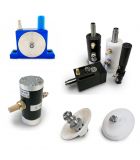
INDUSTRIAL VIBRATION SYSTEMS
<h2>Industrial vibration systems. Buy online at the best price and service</h2> <p>Pneumatic industrial vibrators are elements that transform pneumatic energy supplied through compressed air into kinetic energy, producing a translational, rotational or impact movement whose power is adjustable by the pressure and flow rate of the supplied compressed air.</p> <p>Due to their specific characteristics, many materials in powder, granules or sawdust, when stored in silos, wagons, pipes, pipes, tanks and other containers, tend to adhere to the surface, get stuck and even more so if they contain roughness, folds, corners or surface changes or reduction of pipes. This produces a slowdown or collapse in the flow of the product.</p> <p>Vibration systems are designed to solve these problems caused by design errors or by the specific characteristics of powder or granule materials, thus increasing process efficiency and improving installation safety.</p> <p>To ensure that this anomaly does not occur, we have several systems:</p> <ul style="list-style-type:disc;"><li><strong>Vibrofluidizers</strong> prevent material under pressure, stored in silos or hoppers, from creating vaults or rat holes during discharge. Additionally, Tramontana membrane technology significantly reduces discharge times, improving the efficiency of the entire system. Depending on the type of powder, environment and temperature, the VBS series of products can meet all needs. Mainly recommended for the treatment of powders such as flour, starches, lime, cement, dry chemicals and plastic resins.</li> <li><strong>F-series piston vibrators</strong> represent an excellent alternative to magnetic vibrators for conveying applications such as small channels or vibrating feeders. They are suitable for applications in potentially explosive atmospheres.</li> <li><strong>PG air cannons</strong> are the ideal solution to the problem of vaults and rat holes in silos and hoppers with irregular, dry and light materials, such as fibers, flakes, shavings, wood chips, plastic shavings.</li> <li><strong>Type 100 fluidization plates</strong> are suitable for fine, light and dry powders, ensuring no material flow problems from silos and hoppers at low cost. Continuously fed multi-level applications are envisaged in storage and dosing systems (e.g. for lime), where fluidization is used not only during extraction of material from the silo, but also to keep the material moving during long storage periods. . For applications with powdered foods.</li> <li><strong>K piston vibrators</strong> are particularly suitable for applications in vibratory tubes for transport, vibratory tables for compaction and as a flow aid for unloading silos and hoppers. They are mainly indicated for coarse-grained hygroscopic materials (granules) or electrostatic materials (powders in the plastic or recycling sector) that tend to adhere to the internal walls. Installation of the K series does not require any drilling of the walls, for this reason they are suitable for installation in existing systems.<br /> They are certified by ATEX EX II 2DG cT (x), therefore, they can be used in potentially explosive atmospheres, such as those present in the chemical or food sector.</li> <li><strong>PS hammers</strong> are designed to prevent vaulting and rat holes in silos and hoppers. Their installation does not require any drilling, but only welding, for this reason they are also suitable for installation in existing systems.</li> <li>OR <strong>rotary roller vibrators</strong> are used in silos, hoppers, pipes and chutes, as well as in concrete compaction. Installation does not require drilling into the walls of the application, for this reason they are particularly suitable for integration into existing systems and machinery.</li> <li><strong>Turbine Vibrators, OT.</strong> This OT series has higher vibration speeds than ball and roller vibrators, for this reason, OTs can be used to compact concrete, where a particularly smooth surface finish without porosity is required. The OT series does not need lubricated air, this allows its use in the processing lines of the food industry, as well as in the transport of powders and granules, in compaction, for emptying the hopper and unloading the various materials. silos, channels, slides and pipes.<br /> Installation does not require any drilling in the walls of the application, for this reason they are particularly suitable for integration into existing systems and machinery. The low noise makes them suitable for indoor applications as well.+</li> <li><strong>S series ball vibrators</strong> require lubricated air at a working pressure of 2 to 6 bar (29 ~ 87 PSI). At maximum speed, the noise does not exceed 90 dB (A). They are designed to be used in outdoor applications, for this reason, the body is made of blue anodized aluminum while the covers are in Ixef®, a particular plastic material with high resistance to atmospheric agents and harsh working conditions. The S series is made up of eight different sizes of vibrators. They are particularly efficient when used with fine powders and small non-wet granular materials.</li> <li><strong>P-series continuous linear impact pneumatic vibrators</strong> are particularly suitable for handling materials that tend to stick to silo and hopper walls, chutes, pipes, dump trucks and trailer bodies. Such materials are normally wet or electrostatic powders, clay, salts, sludge and grout residues.<br /> P series vibrators are particularly suitable for integration into existing systems as they do not require any drilling of the walls; They are mounted on a fixing plate (not supplied) to be soldered to the wall to vibrate.</li> </ul><p>The sectors where this entire series of industrial vibrators can be applied are: Food and Food, Construction and Building, Energies, Heavy Industry, Plants and Machinery, Plastics and Chemicals, Environmental Technology. And applications in trucks, big-bag loaders, vibrating cleaning of filters, hoppers, tanks, tubular transport, emptying of hoppers and silos.</p> -

PNEUMATIC TOOLS
<h2>Pneumatic Tools. Buy them online at the best price</h2><p> Pneumatic tools operate by the controlled expansion of compressed air stored in a compressor. This air is channeled through a hose to the tool to generate movement, rotation or impact, depending on the type of tool.</p><h3> Advantages of pneumatic tools:</h3><p> Pneumatic tools are primarily known for reducing vibration and operator fatigue, but they also offer other benefits such as:</p><ul style="list-style-type:disc;"><li> Power: Air tools can generate a lot of power compared to similarly sized power tools, making them ideal for tough jobs.</li><li> Portability: Pneumatic tools are usually lighter and more compact than electric tools, which makes them easier to handle.</li><li> Versatility: There is a wide range of pneumatic tools available for a multitude of tasks, ranging from tightening nuts to demolishing structures.</li><li> Low maintenance: Pneumatic tools typically require little maintenance due to fewer moving components compared to power tools.</li><li> Safety: Pneumatic tools are generally safer than electric tools, as there is no risk of electric shock due to their independence from electricity for operation.</li></ul><h3> Main functions of pneumatic tools:</h3><p> Due to their versatility, pneumatic tools are used to perform a variety of tasks, including: tightening and loosening screws and nuts, drilling and punching, hammering, sanding, painting, cutting, stapling, riveting.</p><h3> Application areas for pneumatic tools</h3><p> Pneumatic tools are very versatile and find applications in a variety of industries. Below we explain their use in each activity:</p><ul style="list-style-type:disc;"><li> Woodworking: used here for nailing, stapling and sanding. Examples include attaching mouldings, creating wood joints and sanding surfaces.</li><li> Metalworking: Cutting, polishing, drilling and riveting metales.Algunos are appropriate in this sector. Some examples include drilling holes in sheet metal, polishing metal surfaces and riveting parts.</li><li> Automotive: These tools are used for tire removal, body repair, painting, and part installation. Examples include impact wrenches for tire changes or paint spray guns for coating.</li><li> Construction: These include tasks such as framing nailer, concrete nail gun, and concrete drilling.</li></ul> -
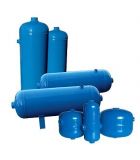
PNEUMATIC ACCESSORIES
<p>Buy pneumatic accessories online</p><p> Pneumatic accessories are all elements related to pneumatics that help implement, assist and improve a compressed air installation.</p><p> There are many elements used, but we can mention the following:</p><ul style="list-style-type:disc;"><li> <strong>Compressed air tanks</strong> . Compressed air tanks are containers used to store compressed air at high pressure. These tanks are commonly used in pneumatic systems, which use compressed air for the operation of tools and machinery, vehicle brake systems and lifting equipment, among others. Compressed air tanks are designed to withstand the high pressure generated by compressed air and to ensure safety in storage and use. They are built with strong and durable materials, such as carbon steel painted in blue RAL-5015 or stainless steel, and are designed with safety systems to prevent leaks and explosions. In general, compressed air tanks can be of different sizes and shapes, ranging from 0.5 liters to 5000 liters or more depending on the specific application for which they are used. These reservoirs are essential for the safe and efficient operation of pneumatic systems and are an important part of many industrial processes.</li><li> <strong>Blow guns and nozzles.</strong> Blower guns are pneumatic tools used to clean and clear surfaces of dust, dirt, chips, metal shavings, hair and other unwanted materials. These tools work by creating a stream of compressed air coming out of a narrow, concentrated nozzle, allowing them to expel unwanted material from surfaces. Blower guns can be powered by compressed air from an air compressor or by a compressed air source built into the tool. They are commonly used in machine shops, factories, warehouses and homes to clean and keep work surfaces clean. They are also used in cleaning electronic equipment and removing dust from sensitive components. There are many types of nozzles, for different applications, depending on their size, short or long nozzles and depending on the application, venturi effect nozzles, with soundproofing effect, etc.<br/> Likewise, the blow nozzles behave in the same way, except that the air flow is constant, fixed and laminated since they have a number of micro holes that distribute the air outlet evenly. They are usually made of technical plastic.</li><li> <strong>Hose reels.</strong> Hose reels are devices designed to store and keep hoses in order and ready for use. These reels are typically made of weather-resistant materials, such as steel and stainless steel, and may be designed for industrial, commercial, or residential uses. Hose reels typically include a mechanism to automatically wind the hose, making the storage process easier. Additionally, some models may include additional features such as locking systems to keep the hose in place once rolled, carrying handles for easy transport, and built-in systems to provide easy access to the hose when needed. They usually have a support to be able to place and tie to the wall or machine. Hose reels are useful for keeping hoses organized and avoiding typical tangles, which can extend hose life and ensure optimal performance when used for blowing, cleaning, or servicing and airing all air tools. There are various hose sizes and lengths for each type of application. Each reel includes <span translate="no">CE</span> Declaration of Conformity for machines according to Directive 2006/42/CE.</li><li> <strong>Tensioners.</strong> Air tool turnbuckles are devices used to hold and secure air tools in place on the machine or equipment that uses them. These turnbuckles are critical components in the transmission of pneumatic energy from the motor or compressed air source to the tool itself, and are designed to ensure a secure and stable connection. Tensioners for air tools can vary in design and configuration, but generally consist of a housing or body that connects to the motor or compressed air system, and an adapter or chuck that is used to hold the tool in place. They also allow, through a spring, to balance the tool ergonomically for better, more comfortable use. Some tensioners may also include additional features, such as quick tool change systems, to facilitate quick and efficient tool replacement. Air tool tensioners are commonly used in a wide range of industrial applications, from mass production to high precision manufacturing. They are also used in many hand tools, such as drills, saws and grinders, to ensure the connection between the tool and the motor or compressed air system. The selection of the most appropriate tensioner must be made based on the weight of the tool it must support, since if the correct tensioner is not placed, the tool will not remain suspended.</li></ul> -
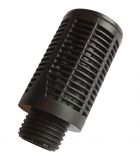
PNEUMATIC MUFFLERS
<h2>Pneumatic silencers. Buy them online at the best price</h2><p> Compressed air silencers, also known as pneumatic silencers or exhaust silencers, are devices designed to reduce the noise generated by pneumatic operations in compressed air systems, since the noise generated is extremely dangerous.</p><p> These mufflers are designed with a series of chambers and perforations that slow the compressed air and direct it through a series of obstacles, such as plates and fibers, that absorb sound. The result is a significant reduction in the noise level generated by the compressed air system.</p><p> Compressed air silencers are available in a variety of sizes and configurations to fit a wide range of applications. When choosing a silencer, it is important to consider the air flow, working pressure and the noise level you want to reduce. Most silencers are placed on the air outlets to evacuate the internal pressure. They are usually threaded and in some cases have a smooth spigot incorporated to be placed directly into a fitting.</p><p> Thread sizes range from M-5 to 2" Pneumatic silencers are designed with different shapes depending on the application. Application specifications that influence the design are housing materials, working temperature ranges, the working pressure range and connection options. They are manufactured in different materials to satisfy all market applications, plastic, stainless, synthetic bronze, polyethylene, fiber, metal, etc...</p><p> Importantly, compressed air silencers not only have a beneficial effect in terms of noise reduction, but can also help improve the efficiency and life of the compressed air system by reducing vibration and minimizing erosion. and wear on components. They are very easy to replace.</p><p> Compressed air silencers are an effective and easy-to-implement solution to reduce the noise produced by pneumatic tools. In addition to improving working conditions, they can also help comply with workplace noise decibel regulations.</p> -
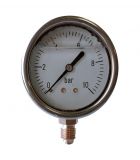
PNEUMATIC MANOMETERS
<p><b>A manometer is an analog or digital gauge used to measure the pressure of a fluid.</b></p> <p><b>The operation of the manometer is carried out through a Bourdon tube, when it receives pressure it extends and transmits a movement to a needle that is described in a sphere previously regulated to an established pressure scale.</b></p> <p><b>They are used in any type of industry where it is required to know the pressure being worked on. Mining, food, steel, petrochemical, energy, automotive, domestic.....</b></p> <p><b>Industrial analogue pressure gauges are basically built with a stainless steel casing and you can select either a brass or stainless steel fitting. They can have a glycerin bath inside, which allows a better definition of the reading.</b></p> <p><b>The scale can vary from 0 to 1000 bar, (see other scales)</b></p> -
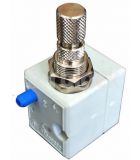
SPRAYING ACCESSORIES
<h2>Spraying Accessories. Buy online at the best price</h2><p> Spraying is a process that involves the transformation of a solid or liquid material into small fine particles, generally with the aim of facilitating their dispersion or application in a liquid or gaseous medium. This process can be carried out by different techniques such as mechanical pulverizing (using mills or crushers), thermal pulverizing (using thermal energy to produce fine particles), chemical pulverizing (involving chemical reaction to produce fine particles). fine), and spraying through the venturi effect.</p><p> This uses a liquid medium, which together with the air pressure with the venturi effect we get that liquid to produce a spray, a fine mist regulated with a screw, to be able to give more or less fan.</p><p> Pneumatic sprayers have some advantages compared to other types of sprayers, such as greater uniformity in liquid application, greater efficiency in surface coverage, and the ability to reach difficult-to-apply areas. However, they may also have some disadvantages, such as higher purchase cost and higher energy consumption due to the use of an air compressor.</p><p> They are made of aluminum or polyamide, depending on the application used. The inlet holes for both compressed air and liquid are threaded to M-5. Nothing should be placed at the outlet of the sprayer as it would lose the mist effect it produces. It is applied directly to the place where the spray is required. It also has a built-in anti-drip system to avoid those cumbersome drops that could fall at the end of the cycle.</p><p> Spraying is used in a wide variety of industries and applications, such as agriculture (for the application of pesticides), pharmaceutical (for the production of medicines in aerosol form), food (for the production of powders and spices), cosmetics (for the production of powder makeup) and electronics (for the production of powder electronic components).</p> -
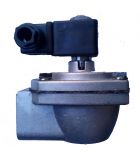
PNEUMATIC SOLENOID VALVES
<h2><strong>Pneumatic solenoid valves. Buy them online at the best price</strong></h2><p> <strong>Pneumatic solenoid valves are the variant of an electromechanical valve</strong> generally used to control the flow of a liquid or gas. There are different types of solenoid valves, although the most important variants are servo-assisted and direct-acting solenoid valves.</p><p> <strong>Servo-assisted valves</strong> are the most widely used, and use pressure from the same line of the system to open and close the main orifice of the valve body.</p><p> <strong>Direct acting solenoid valves directly</strong> open or close the valve body orifice, which represents the only flow path inside the valve. They are used in systems that require low flow capacities or in low pressure applications, since they can open without pressure.</p><p> Pneumatic solenoid valves can have many variants and configurations. It can be 2 or 3 ways. Normally open or normally closed. They are activated and deactivated by a solenoid, through electrical impulses. This generates a magnetic field that displaces a nucleus, opening or closing the passage hole.</p><p> Solenoid valves are the most frequently used control elements in fluid technology. They are typically used to cut, release, dispense, distribute or mix fluids. That is why they can be found in many areas of application. The solenoid valves provide fast and safe switching, high durability and reliability, low control power and a compact design.</p><p> The <strong>extensive range of applications</strong> such as; water supply and treatment, refrigeration, fuels, gases, process control, bag filter blowing, cryogenics, food, compressed air, chemicals</p><p></p> -
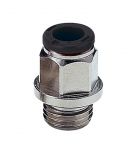
PNEUMATIC FITTINGS
<h2><strong>Pneumatic Fittings. Buy online at the best price with 24/48 hour shipping.</strong></h2><p> There are several many types of fittings commonly used in pneumatic systems and equipment.</p><p> These are some of the most used types:</p><p> <strong>Push-to-Connect Fittings</strong> Also known as <strong>quick connect fittings</strong> , instant fittings or one-touch fittings, these fittings allow for quick and easy connections without the need for additional tools. They have a push mechanism that securely holds the tube in place. Push-to-connect accessories are popular for their simplicity and convenience. They can be made of plastic, brass or stainless steel.</p><p> <strong>Compression or Nut and Bicone Fittings</strong> – Compression fittings create a seal by compressing a ferrule, bicone or oval, around the tube or hose. They consist of a nut, a compression ring (ferrule) and a body. When you tighten the nut, the ferrule is compressed onto the tube, forming a firm, secure connection. Compression fittings are reliable and suitable for high pressure applications. Once the bicone or ferrule is pressed, it cannot be reused. They are made of brass, plastic or stainless steel.</p><p> <strong>Barb Fittings:</strong> Barb fittings have a serrated or slotted barb end that grips the inside of the tube or hose. They are typically used with flexible tubing and require the use of hose clamps to secure the connection. Spigot fittings are cost effective and widely used in low pressure pneumatic systems. They are made of stainless steel and nickel-plated brass.</p><p> <strong>Threaded Fittings:</strong> Threaded fittings have male or female threads that screw into corresponding threaded ports or connectors. They provide a secure, leak-proof connection and are commonly used in applications requiring higher pressure or larger pipe sizes. Threaded fittings often require the use of thread sealant, such as Teflon tape or thread sealing compound, to ensure a proper seal. They are made of stainless steel and nickel-plated brass.</p><p> All these types of pneumatic fittings have endless applications and are used in all types of industry.</p>
We distribute systems for the industrial automation of pneumatic systems: Cylinders, directional valves, auxiliary valves, fittings, accessories, pipes, tools, fluid valves, air treatment, actuators, industrial vibration, spraying and misting.
All types of cylinders according to ISO/VDMA, CNOMO standards, telescopic, guides, standard and upon request. Wide variety of options, sensors and fixings. Cylinders for the food industry made of INOX.
Wide range of directional valves. Process solenoid valves in sizes from M5 to 1/2”. Other valves to control flow, pressure, etc. for in-line mounting as well as on a plate or panel. Slide valves with manual, electric or pneumatic operation. ISO valves and micro valves. Multipolar solenoid valves. Field bus. Logic. Elements for manipulating pneumatic signals.
Filters, Regulators, Lubricators, fully modular, tool-free assembly combinations. Desolation filters and submicron filtration. Electronic purges, compressors and dryers, pressure multipliers. Available in 316 stainless steel, for aggressive environments and the food industry.
We supply fluidization elements for hoppers and tanks. Vibrators, percussion hammers, air cannons, impact cylinders.
All types of accessories for pneumatics. Fittings and tubing. Hoses (both polyamide and polyurethane), guns, safety valves, boilers, blowing technique, reels, pressure multipliers.
Pneumatic and electric actuators, in single and double acting, mounted on a wide variety of valves for different industrial, chemical, food, etc. sectors.
Wide range of solenoid valves for fluids. Sizes ranging from 1/8” to 2” and various joints depending on the fluid. Blow valves for bag filters. Covers most industrial needs. Direct action, indirect action, mixed control, external piloting, blowing of bag filters. Complete range in INOX.

